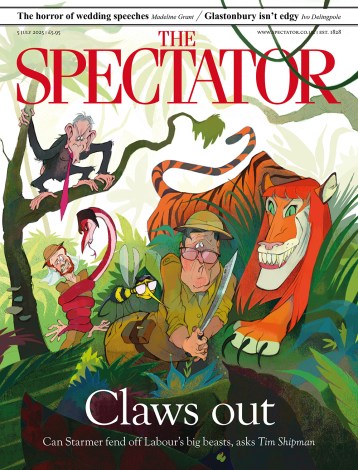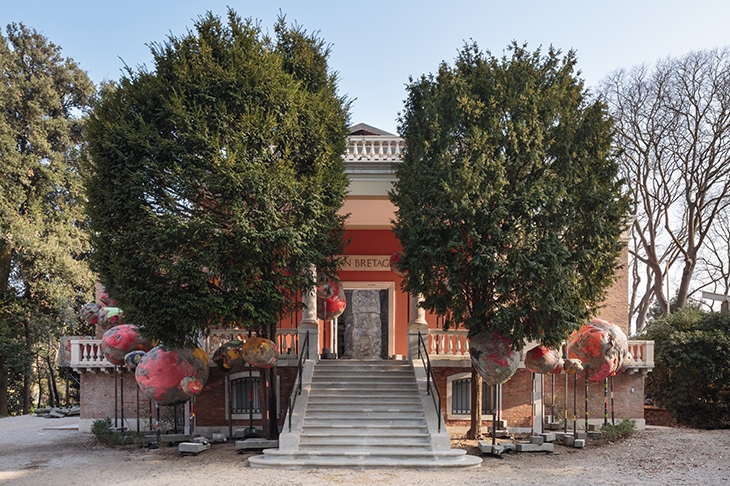‘Are you enjoying the Biennale?’ is a question one is often asked while patrolling the winding paths of the Giardini and the endless rooms of the Arsenale. It is not easy to answer. The whole affair is so huge, so diverse and yet — in many ways — so monotonous. Like the EU, an organisation with which it has something in common, La Biennale di Venezia believes in the principle of subsidiarity. Therefore individual nations are allowed to do what they like within their own pavilions. However, there are also strong homogenising forces at work — so much of what is on view in the national pavilions and elsewhere tends to fall into certain approved categories: notably video art, photography (often rather dull) and messy installation.
Phyllida Barlow, batting for Britain on this occasion, has opted for the last of those. Her exhibition, entitled Folly, has some stereotypical British characteristics. It looks (deliberately) provisional, amateurish and bodged: as if a giant toddler had been presented with a pile of art materials and told to make a full-scale model of a building site.
Outside there are huge, vaguely spherical objects on sticks, spattered with red, looking like balloons fashioned from heavily preused Play-Doh. Inside, the roof seems to be supported by mighty pillars made from cement and sacking. All around are big ungainly objects: an enormous cone of untidy red wire, a pair of rough-hewn wheels on an axle, a megaphone.
Altogether it has a ramshackle charm, especially in comparison with the German contribution next door, which is downright fearsome. The artist, Anne Imhof, has placed wire cages in front of the building, patrolled by Doberman pinschers and a squad of soberly-clad attendants. Within, you encounter more performers writhing under a transparent floor and trapped in sealed compartments.
I preferred the neighbouring Canadian Pavilion — which has been semi-dismantled and turned into a fountain — and, even more, the Austrian one. Outside this Erwin Wurm has upended a lorry, so that its radiator grill is pressed to the ground, and turned it into a tower up which you can climb — a contemporary addition to the Venetian sky-line of chimneys and campaniles.
The Scottish Pavilion, in a disused medieval church near the Fondamente Nove, also sticks in the mind. It consists of a bizarre filmed fantasia — half-Disney, half nightmare — projected where the altar would once have been. The characters — all played by the artist, Rachel Maclean, herself — include a Pinocchio lookalike and a Madonna substitute.
However, I would have given the top prize for a national pavilion to New Zealand (in fact, the jury awarded it to Germany). This also features moving pictures in a highly original way. The artist, Lisa Reihana, took as her starting point early 19th-century French wallpaper depicting Captain Cook’s voyages to the South Seas, reshot each episode — the exploits of the botanist Joseph Banks, the death of Cook — with actors, and edited the whole into a vast, moving panorama past which the viewer walks.
Just as Caesar described ancient Gaul, the Biennale is divided into three parts: the national pavilions, collateral events and its own, colossal exhibition that has been organised by the director of this 57th edition, Christine Macel. Furthermore, like Brussels again, it revels in verbal formations that are, to an Anglo-Saxon mind, bewildering.
The name of this year’s exhibition is upbeat if meaningless: Viva Arte Viva. But this vast agglomeration of contemporary this and that, which extends through the 16th-century buildings of the Arsenale and also the large central pavilion in the gardens, is further subdivided into nine mystifying portions, which include the Pavilion of Joys and Fears, the Dionysian Pavilion and the Pavilion of Time and Infinity.
It is quite easy to go from one of these to the next without noticing the difference —although the Pavilion of Artists and Books does in fact contain quite a few volumes, including many slightly burnt ones stuck to canvases by the late John Latham.
There is plenty more video, boring photography and messy installation on show in Viva Arte Viva. But also some less classifiable attractions scattered here and there. The Brazilian artist Ernesto Neto has put together a floppy, woven tent-like structure where a number of Huni Kuin, an Amazonian people, are seated, offering to perform healing ceremonies on passing lovers of contemporary art (a change from the prosecco, which traditionally flows more freely than water at Biennale time).
At the end of the grand enfilade of the Arsenale is a wall covered in gigantic cascading brightly-hued balls of wool, a work by Sheila Hicks and one of the few pieces that offers a real eyeful of visual pizzazz (this must be part of the ‘Pavilion of Colours’).
Elsewhere, there is plenty of that in a delightful exhibition by Stephen Chambers at the Ca’ Dandolo, on the Grand Canal, The Court of Redonda — a gallery of 101 imaginary citizens of an uninhabited Caribbean island painted in colours as varied as, but more subtly harmonious than, all that wool.
Also officially ‘collateral’, but in artistic terms the most notable show in the Biennale, is Philip Guston and the Poets at the Gallerie dell’Accademia. This has a debateable premise: that Guston was affected by, and had an affinity with, a number of 20th-century writers. It is hard not to wonder whether Guston really spent much time reading Eugenio Montale, for example, or W.B. Yeats. But as a selection of works from his final, figurative period it is hard to beat. Guston is an example of an artist who got better as he grew older. Starting out as a rather kitschy narrative painter, he went on to become a second-string abstract expressionist, before finally discovering a strange visual poetry in pictures of such items as dustbin lids and hobnail boots.
So the answer to that question — are you enjoying the Biennale? — is complicated. This time it is, by turns, bemusing, revealing, numbingly uninteresting and great fun. But then it’s always like that.






Comments